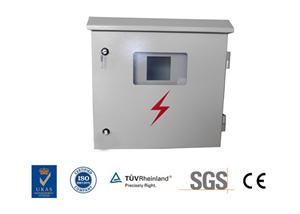शीट मेटल झुकने का अनुभव
एक: झुकने मशीन के टन भार आयन
झुकने की प्रक्रिया के दौरान, ऊपरी और निचले मरने के बीच का बल सामग्री पर लागू होता है, जिससे सामग्री को बहुत अधिक ख़राब होता है। कार्य टन भार झुकने के दौरान झुकने के दबाव को संदर्भित करता है। कार्य टन निर्धारित करने के लिए प्रभावशाली कारक हैं: झुकने त्रिज्या, झुकने विधि, मोल्ड अनुपात, कोहनी की लंबाई, झुकने की सामग्री की मोटाई और ताकत, आदि।
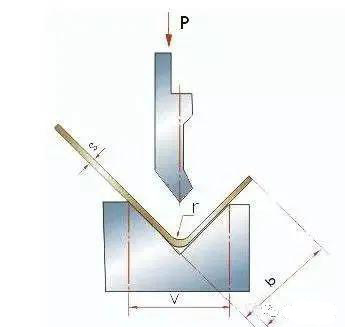
आम तौर पर, कार्यशील टन निम्न तालिका के अनुसार संपादित किया जा सकता है और प्रसंस्करण मापदंडों में निर्धारित किया जा सकता है।
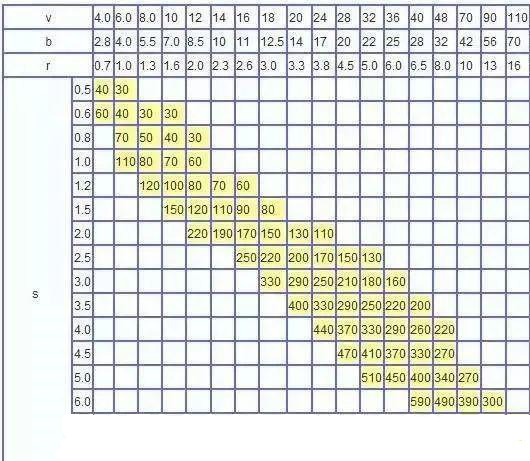
1. शीट की लंबाई एक मीटर होने पर तालिका में मूल्य झुकने का दबाव होता है:
उदाहरण: S = 4 मिमी L = 1000 मिमी V = 32 मिमी
तालिका देखें और P = 330kN प्राप्त करें
2. इस तालिका की गणना सामर्थ्य isb = 450N / mm2 के साथ सामग्री के आधार पर की जाती है। अन्य सामग्रियों को झुकाते समय, झुकने वाला दबाव तालिका और निम्न गुणांक में डेटा का उत्पाद है;
कांस्य (नरम): 0.5;
स्टेनलेस स्टील: 1.5;
एल्यूमीनियम (नरम): 0.5;
क्रोमियम-मोलिब्डेनम स्टील: 2.0।
3. झुकने के दबाव की अनुमानित गणना सूत्र
पी = 650s2L / 1000v
पी - के.एन.
एस - मिमी
एल - मिमी
वी - मिमी
झुकने की तुलना तालिका
B. आमतौर पर शीट मेटल झुकने में समस्याओं का सामना करना पड़ा
1) आम तौर पर झुकने वाले मर जाते हैं
सामान्य रूप से झुके हुए सांचे का उपयोग किया जाता है, जैसा कि नीचे दिखाया गया है। मोल्ड के जीवन को लम्बा करने के लिए, भागों को यथासंभव गोल कोनों के साथ डिज़ाइन किया गया है।
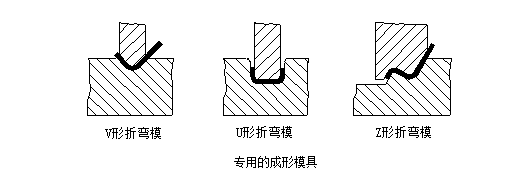
यदि निकला हुआ किनारा की ऊंचाई बहुत छोटी है, तो एक झुकने मरने का उपयोग करने के लिए भी अनुकूल नहीं है। आम तौर पर, निकला हुआ किनारा ऊंचाई L≥3t (दीवार की मोटाई सहित)।
कदम प्रसंस्करण विधि
कुछ लो-प्रोफाइल शीट मेटल ज़ेड-शेप्ड स्टेप झुकने के लिए, प्रसंस्करण निर्माता अक्सर पंच या हाइड्रोलिक प्रेस पर प्रक्रिया करने के लिए सरल सांचों का उपयोग करते हैं, और छोटे बैचों को भी स्टेप डाई के साथ झुकने वाली मशीन पर संसाधित किया जा सकता है, जैसा कि निम्नलिखित आंकड़े में दिखाया गया है। हालाँकि, ऊँचाई H बहुत अधिक नहीं होनी चाहिए, आम तौर पर (0 ~ 1.0) t होना चाहिए, यदि ऊँचाई (1.0 ~ 4.0) t है, तो इसके अतिरिक्त और डिस्चार्ज संरचना के ढालना रूप के उपयोग पर विचार करना आवश्यक है वास्तविक स्थितियों के लिए।
इस ढालना कदम की ऊंचाई को शिम जोड़कर समायोजित किया जा सकता है, इसलिए ऊंचाई एच को मनमाने ढंग से समायोजित किया जा सकता है, लेकिन एक नुकसान यह भी है कि लंबाई एल आकार की गारंटी देना आसान नहीं है, और ऊर्ध्वाधर पक्ष की लंबाई के लिए आसान नहीं है गारंटी। यदि ऊंचाई एच आकार बड़ा है, तो झुकने वाली मशीन पर झुकने पर विचार करना आवश्यक है।
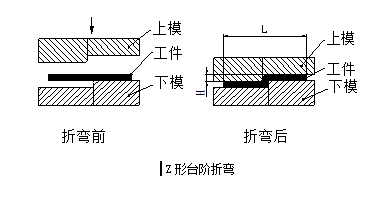
झुकने वाली मशीन दो प्रकार की होती है: साधारण झुकने वाली मशीन और सीएनसी झुकने वाली मशीन। उच्च परिशुद्धता आवश्यकताओं और अनियमित झुकने के आकार के कारण, संचार उपकरणों की शीट धातु झुकने आमतौर पर एक सीएनसी झुकने मशीन के साथ मुड़ी हुई है। मूल सिद्धांत झुकने वाली मशीन के झुकने वाले चाकू (ऊपरी डाई) और वी-नाली (निचले) का उपयोग करना है। मरो), झुकने और शीट धातु भागों का निर्माण।
लाभ: सुविधाजनक क्लैंपिंग, सटीक स्थिति और तेजी से प्रसंस्करण गति;
नुकसान: कम दबाव, केवल सरल बनाने और कम दक्षता की प्रक्रिया कर सकता है।
बनाने के बुनियादी सिद्धांत
बनाने का मूल सिद्धांत नीचे दी गई आकृति में दिखाया गया है:
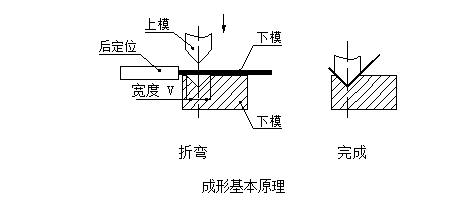
झुकने वाला चाकू (ऊपरी मरना)
झुकने वाले चाकू का रूप नीचे की आकृति में दिखाया गया है। यह मुख्य रूप से प्रसंस्करण के दौरान वर्कपीस के आकार के अनुसार एड होता है। आम तौर पर, प्रसंस्करण निर्माताओं के कई झुकने वाले चाकू के आकार होते हैं, विशेष रूप से उच्च विशेषज्ञता वाले। विभिन्न जटिल झुकने की प्रक्रिया के लिए, कई आकृतियों और विशिष्टताओं के झुकने वाले चाकू अनुकूलित किए जाते हैं।
निचली डाई आमतौर पर V = 6t (t सामग्री की मोटाई होती है) डाई का उपयोग करती है।
कई कारक हैं जो झुकने की प्रक्रिया को प्रभावित करते हैं, जिसमें मुख्य रूप से ऊपरी डाई चाप, सामग्री, सामग्री की मोटाई, कम मरने की शक्ति, कम मरने के आकार और अन्य कारकों का त्रिज्या शामिल है। उत्पाद की जरूरतों को पूरा करने के लिए, निर्माता ने झुकने वाली मशीन की सुरक्षा सुनिश्चित करने की शर्त के तहत पहले से ही झुकने वाले चाकू के ढालना को क्रमबद्ध किया है। हमें संरचनात्मक डिजाइन प्रक्रिया के दौरान मौजूदा झुकने वाले चाकू मोल्ड की सामान्य समझ होनी चाहिए। नीचे दी गई आकृति को देखें, ऊपरी डाई बाईं तरफ है और निचली डाई दाईं ओर है।

झुकने के अनुक्रम अनुक्रम के बुनियादी सिद्धांत:
(1) अंदर से बाहर की ओर झुकना;
(2) छोटे से बड़े तक झुकना;
(3) पहले विशेष आकृति को मोड़ो, और फिर सामान्य आकृति को मोड़ो;
(4) पिछली प्रक्रिया बनने के बाद, यह बाद की प्रक्रिया को प्रभावित या बाधित नहीं करता है।
The current bending form is generally shown in the following figure:
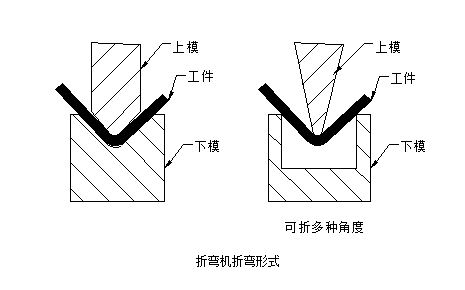
2) Bending radius
When bending sheet metal, a bending radius is required at the bending place. The bending radius should not be too large or too small, and should be ed appropriately. If the bending radius is too small, it is easy to cause cracking at the bending point, and if the bending radius is too large, the bending is easy to rebound. The preferred bending radius (inner bending radius) of various materials with different thicknesses is shown in the table below
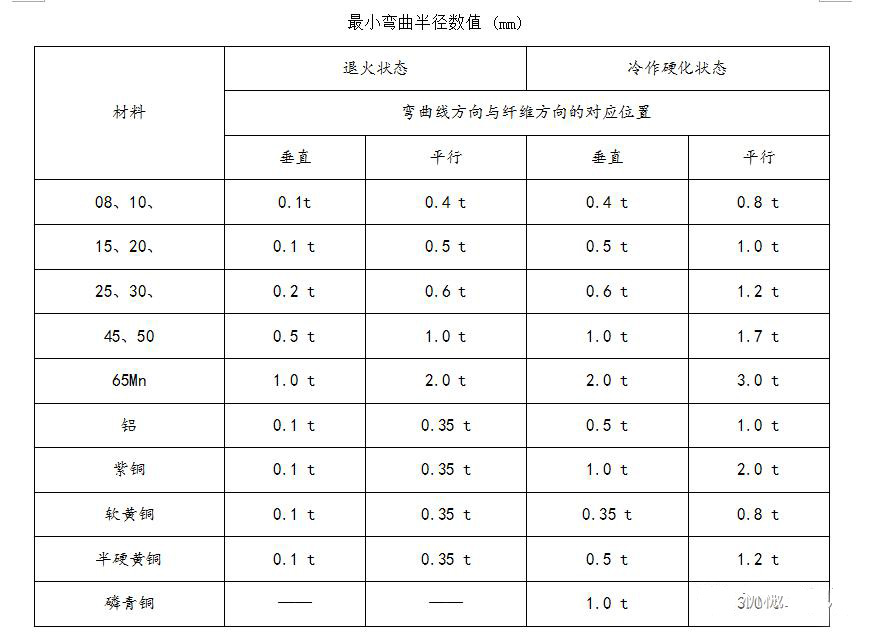
The data in the table above is the preferred data, for reference only. In fact, the corners of manufacturers' bending knives are usually 0.3, and a small number of bending knives are 0.5.
For ordinary low-carbon steel plate, rust-proof aluminum plate, brass plate, copper plate, etc., the inner fillet 0.2 is no problem, but for some high-carbon steel, hard aluminum, super hard aluminum, this bending round It will cause bending breakage or cracking of the outer corners.
3) Bending and rebound
Springback angle Δα = b-a
Where b——the actual angle of the part after rebound;
a—The angle of the mold.
The size of the rebound angle
See the table below for the springback angle when a single angle is 90 ° free bending.
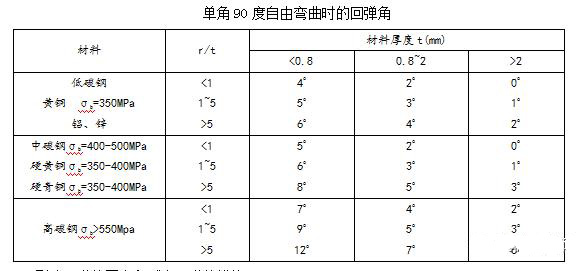
Factors affecting rebound and measures to reduce rebound
① The mechanical properties of the material The rebound angle is directly proportional to the yield point of the material and inversely proportional to the elastic modulus E. For sheet metal parts with high accuracy requirements, in order to reduce springback, the material should be ed as low-carbon steel as possible, not high-carbon steel and stainless steel.
② The larger the relative bending radius r / t, the smaller the degree of deformation and the greater the rebound angle Δα. This is a relatively important concept. The rounded corners of sheet metal bending should be as small as possible, as long as the material properties allow, to improve accuracy. In particular, pay attention to avoid designing large arcs as much as possible, as shown in the following figure, such large arcs have greater difficulty in production and quality control:
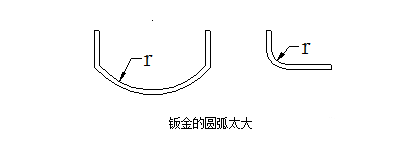
4) Calculation of the minimum bending edge in one bending
The initial state of the L-shaped bend at the time of bending is shown below:
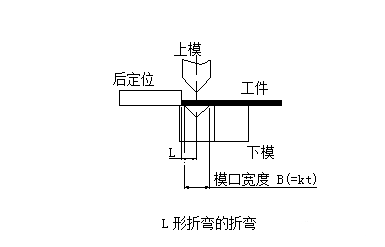
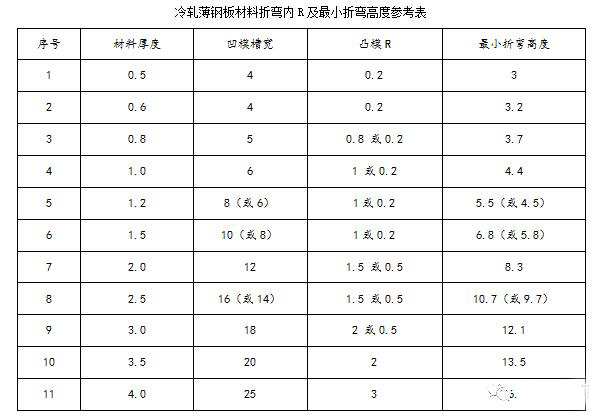
The initial state of the Z-shaped bending at the time of bending is shown in the figure below

The minimum bending dimension L corresponding to the Z-bending of sheet metal with different material thickness is shown in the following table:
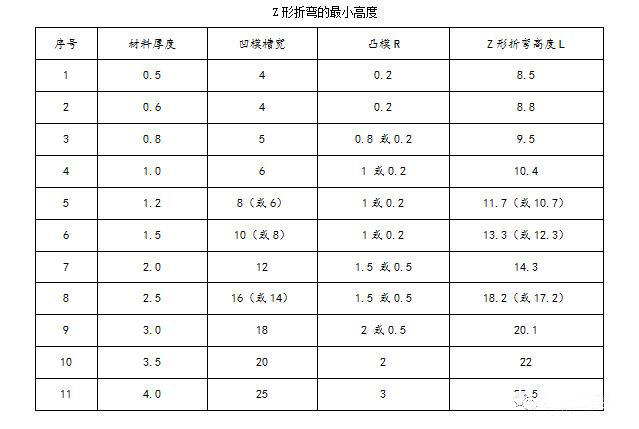
C. Fast calculation method of sheet metal bending and unfolding
When the sheet metal bending and flattening, one side of the material will be elongated and one side will be compressed. The factors affected are: material type, material thickness, material heat treatment and processing bending angle.
Expand calculation principle:
1) During the bending process, the outer layer is subjected to tensile stress and the inner layer is subjected to compressive stress. Between tension and compression, there is a transition layer that is neither tensile nor compressive, called the neutral layer; the neutral layer is bent during the bending process The length is the same as before bending, so the neutral layer is the benchmark for calculating the unfolded length of the bending piece.
2) The position of the neutral layer is related to the degree of deformation. When the bending radius is large and the bending angle is small, the degree of deformation is small. The position of the neutral layer is close to the center of the sheet thickness; when the bending radius becomes small, the bending angle increases When it is large, the degree of deformation increases accordingly, and the position of the neutral layer gradually moves to the inside of the bending center. The distance from the neutral layer to the inside of the sheet is expressed by λ.
On the other hand, with the emergence and popularization of computer technology, in order to make better use of the computer's super analysis and calculation capabilities, people increasingly use computer-aided design, but when computer programs simulate the bending of sheet metal Or it needs a calculation method in order to accurately simulate the process.
Although only to complete a certain calculation, each store can customize a specific program according to its original pinch rules, but nowadays, most commercial CAD and three-dimensional solid modeling systems have provided more general and Powerful solution.
ज्यादातर मामलों में, ये एप्लिकेशन सॉफ़्टवेयर मूल अनुभव-आधारित और फिंगर पिंच नियमों के साथ भी संगत हो सकते हैं, और इसकी गणना प्रक्रिया में विशिष्ट इनपुट सामग्री को अनुकूलित करने का एक तरीका प्रदान करते हैं। सॉलिडवर्क्स स्वाभाविक रूप से इस शीट धातु डिजाइन क्षमता प्रदान करने में एक नेता बन गया है।




